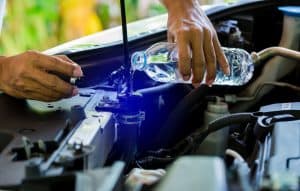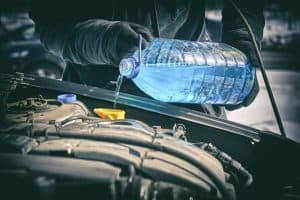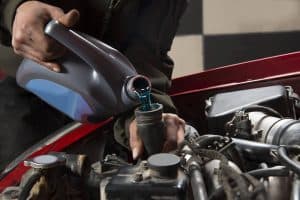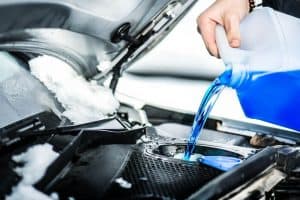Some car owners hold questions on whether they should add water or coolant to their car radiator. Knowing what to do to your care is the best care and maintenance one can offer. Adding water into your radiator is a misconception that lives in us, and we live in it too.
Understanding how the car radiator works is always advisable, and once you get educated, you will never top up the car radiator with distilled water. The short answer to this question is YES; adding water to your radiator when the car overheats can solve the situation. However, it would help if you made sure that you use soft water. Don’t run for distilled water; it can work but not a suitable option.
Everything you need to know on whether to add water or coolant to your car radiator
-
Distilled water is not the solution

You will meet a lot of information online, recommending to top up your radiator with distilled water in the name of cooling the vehicle. You will even see prominent mechanics adding distilled water to their car radiator; this doesn’t seem right, especially for experienced lads.
The thought here is that the distilled water doesn’t have minerals, not leaving build-ups in the radiator and hoses. This process is only good in theory, but in a real sense, distillation is not considered why you should not add distilled water into your vehicle’s radiator.
During the distillation process, water is heated at a gaseous phase, leaving behind magnesium and calcium build-ups when it boils off. The evaporation process takes place to strip minerals from the distilled water.
While we require water that doesn’t have these minerals as a coolant, the distillation process will leave your water ionically unbalanced. Essentially your distilled water will lack an electron, making it unstable. Therefore, the distilled water can damage the metallic parts of your engine under repeated usage.
During evaporation, the magnesium and calcium leave together with electrons, leaving a yearning solution to stabilize itself with eight valence electrons. So when you add distilled water to your engine block, the water will eat electrons from the metallic parts it meets.
So you need to make sure that you avoid distilled water completely because it will still damage your car engine’s components differently.
-
Go for soft water for excellent results

Experienced experts recommend using soft water in place of coolants. Water undergoes a softening process, removing minerals from it. This means that you can still use tap water that contains some small amounts of iron, magnesium, and calcium. Therefore, unlike distilled water, soft water doesn’t have minerals like magnesium and calcium.
However, the process of mineral removal is completely different. What makes the softening process unique is that sodium ion is added into your water once the minerals are eliminated. So instead of the water having magnesium and calcium minerals, they are replaced with the sodium ion.
The solution you get here is more stable and will not react with your car engine’s metallic parts. Therefore, experts recommend using soft water because it cannot destroy and damage the vehicle’s internal parts.
More so, unlike distilled water, soft water won’t consume electrons from the engine block. No damage will happen to your engine. Remember, repairing a damaged engine is quite expensive, so try as much to get soft water. Failure to do that will force you to repair the entire engine if distilled water is used regularly.
Softened water remains safe for your engine since it can’t damage or destroy your engine’s metallic parts. Avoid using distilled or tap water in the form of a coolant. Don’t fasten the age of your vehicle; stick to softened water.
You might be interested to read also:Important Is It To Change The Oil In Your Car
You can make your soft water using a softener
Now that you know softened water is important for your car cooling system, the next thing will be how to get it. You can decide to make yours right at home and mix it with the available antifreeze.
You can buy softened water or make yours. You can inquire from your friends or neighbors if they have a softener in their homes. Don’t borrow the softener machine; ask for a little softened water. Use the following step by step guide to making your softened water:
- Boil your distilled or tap water
- Give the water enough time to cool. If the water is hard temporarily, it probably has magnesium and bicarbonate ions. Boiling is enough to fix this issue. However, if the water is permanently hard, it has magnesium and calcium sulfates. Go on to the next step once your water is completely cooled down.
- Top up your soft water with a washing soda. There’s no difference between baking soda and washing soda. Follow the available instructions concerning the mixing proportions.
Antifreeze or coolant? Which substance should mix with my softened water?
It’s possible to use engine coolant and antifreeze interchangeably. However, they are two different things. Engine coolant is simply the liquid mixed solutions surging through your car’s engine block to prevent it from overheating. As its name suggests, this is a mixed solution made up of several blended substances.
On the other hand, antifreeze is the ethylene glycol chemical found in some pre-blended engine coolants. Besides, you can buy these blends separately and mix them with your softened water and add them to your vehicle’s cooling system.
What are some of the coolants to use in my car
There are several types of coolants from different manufacturers; it could be awkward if all manufacturers produce similar coolants. For these reasons, it’s advisable to revise your vehicle’s user manual to determine which one is an appropriate/compatible engine coolant.
These coolants exist in three different categories, i.e., organic acid technology, hybrid organic acid, and inorganic additive technology.
- IATF
This type of coolant is quite outdated and not powerful compared to its counterparts on the market. Some newer models are more effective when it comes to the engine coolant world. You are likely to find this solution in older cars.
Therefore, if your vehicle utilizes this type of coolant, it’s advisable to regularly flush your system, replacing the coolant. Inorganic additive technology coolant should be changed after every 24000 miles, i.e., two years. This is sooner than newer coolant solutions on the market.
- OAT
Here is another coolant that seems to be a bit more powerful than the above model. It wont stress you as it requires less upkeep and maintenance. It is commonly compatible with newer vehicles from the year 2000. You will have to change the coolant after every 150000 miles, which is equivalent to five years.
This is an excellent distance coverage that you can move around with without changing the coolant. Therefore, such a coolant can save you some money and time too that could be used on regular maintenance. The solution is often orange-yellow, but sometimes it changes based on the manufacturer.
Furthermore, the substance is sourced from completely neutralized organic azoles and acids. These components are the ones making the coolant anti-corrosive. Hence the origin of the fluid’s Organic Acid Technology name.
- HOAT
Hybrid Organic Acid Technology is another good coolant solution that one can opt for. It slightly resembles the OAT fluid with similar replacement cycles. This means that it’s also reliable when it comes to functionality; you won’t undergo replacement hassles sooner.
Frequently asked questions:
- Am I supposed to add coolant straight to my radiator?
Top up your radiator with coolant to the maximum mark; it should be full when cold. During heat-ups, you are likely to lose all the coolant solutions from the radiator. Therefore, pulling extra coolant from the recovery tank will be an issue. In such a case, the immediate solution is to top up the radiator directly.
- Is it advisable to use water as a coolant?
Yes, if it’s the only way out during an emergency. However, this is always not advisable because water will not work well beyond the boiling and freezing and points. So, this could lead to chronic engine damage, forcing you to spend more for repair or replacement.
- Should I mix antifreeze and water in the radiator?
No! Mixing tap water with a coolant is not advisable. Tap water has some minerals like magnesium and calcium that can develop build up deposits in the radiator.
- How long can I drive with an empty radiator?
It depends on where you come from; if it’s cold areas, your vehicle can extend distance with an empty radiator. Areas with high temperatures require immediate water fill-up.
Conclusion
From the above discussions, you can realize that it’s possible to add water into your car radiator, but be ready for backfires. Using distilled water as a coolant is dangerous to your car engine, as it can lead to magnesium and calcium deposits. Experts recommend using softened water due to the available sodium ions that are not harmful to your engine block; the substance replaces magnesium and calcium minerals.
Distilled water shouldn’t be the answer because it can still rust, corroding from tap, mineral, or water. Therefore, adding coolant to your car engine is the best option, but it can be a bit expensive. For these reasons, it’s advisable to mix the coolant liquid with softened water.
